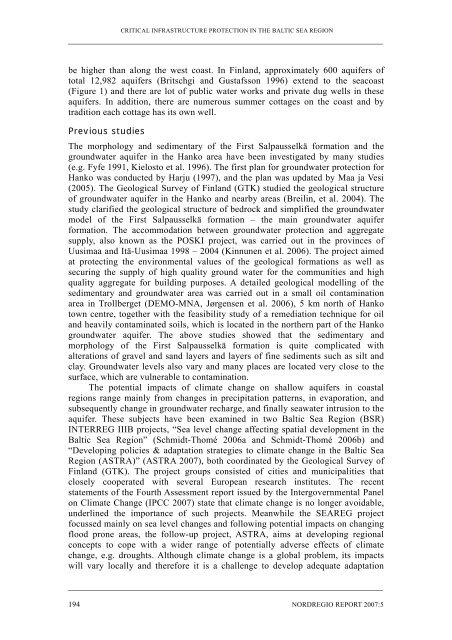Towards a Baltic Sea Region Strategy in Critical ... - Helsinki.fi
Towards a Baltic Sea Region Strategy in Critical ... - Helsinki.fi
Towards a Baltic Sea Region Strategy in Critical ... - Helsinki.fi
Create successful ePaper yourself
Turn your PDF publications into a flip-book with our unique Google optimized e-Paper software.
CRITICAL INFRASTRUCTURE PROTECTION IN THE BALTIC SEA REGION<br />
be higher than along the west coast. In F<strong>in</strong>land, approximately 600 aquifers of<br />
total 12,982 aquifers (Britschgi and Gustafsson 1996) extend to the seacoast<br />
(Figure 1) and there are lot of public water works and private dug wells <strong>in</strong> these<br />
aquifers. In addition, there are numerous summer cottages on the coast and by<br />
tradition each cottage has its own well.<br />
Previous studies<br />
The morphology and sedimentary of the First Salpausselkä formation and the<br />
groundwater aquifer <strong>in</strong> the Hanko area have been <strong>in</strong>vestigated by many studies<br />
(e.g. Fyfe 1991, Kielosto et al. 1996). The <strong>fi</strong>rst plan for groundwater protection for<br />
Hanko was conducted by Harju (1997), and the plan was updated by Maa ja Vesi<br />
(2005). The Geological Survey of F<strong>in</strong>land (GTK) studied the geological structure<br />
of groundwater aquifer <strong>in</strong> the Hanko and nearby areas (Breil<strong>in</strong>, et al. 2004). The<br />
study clari<strong>fi</strong>ed the geological structure of bedrock and simpli<strong>fi</strong>ed the groundwater<br />
model of the First Salpausselkä formation – the ma<strong>in</strong> groundwater aquifer<br />
formation. The accommodation between groundwater protection and aggregate<br />
supply, also known as the POSKI project, was carried out <strong>in</strong> the prov<strong>in</strong>ces of<br />
Uusimaa and Itä-Uusimaa 1998 – 2004 (K<strong>in</strong>nunen et al. 2006). The project aimed<br />
at protect<strong>in</strong>g the environmental values of the geological formations as well as<br />
secur<strong>in</strong>g the supply of high quality ground water for the communities and high<br />
quality aggregate for build<strong>in</strong>g purposes. A detailed geological modell<strong>in</strong>g of the<br />
sedimentary and groundwater area was carried out <strong>in</strong> a small oil contam<strong>in</strong>ation<br />
area <strong>in</strong> Trollberget (DEMO-MNA, Jørgensen et al. 2006), 5 km north of Hanko<br />
town centre, together with the feasibility study of a remediation technique for oil<br />
and heavily contam<strong>in</strong>ated soils, which is located <strong>in</strong> the northern part of the Hanko<br />
groundwater aquifer. The above studies showed that the sedimentary and<br />
morphology of the First Salpausselkä formation is quite complicated with<br />
alterations of gravel and sand layers and layers of f<strong>in</strong>e sediments such as silt and<br />
clay. Groundwater levels also vary and many places are located very close to the<br />
surface, which are vulnerable to contam<strong>in</strong>ation.<br />
The potential impacts of climate change on shallow aquifers <strong>in</strong> coastal<br />
regions range ma<strong>in</strong>ly from changes <strong>in</strong> precipitation patterns, <strong>in</strong> evaporation, and<br />
subsequently change <strong>in</strong> groundwater recharge, and f<strong>in</strong>ally seawater <strong>in</strong>trusion to the<br />
aquifer. These subjects have been exam<strong>in</strong>ed <strong>in</strong> two <strong>Baltic</strong> <strong>Sea</strong> <strong>Region</strong> (BSR)<br />
INTERREG IIIB projects, “<strong>Sea</strong> level change affect<strong>in</strong>g spatial development <strong>in</strong> the<br />
<strong>Baltic</strong> <strong>Sea</strong> <strong>Region</strong>” (Schmidt-Thomé 2006a and Schmidt-Thomé 2006b) and<br />
“Develop<strong>in</strong>g policies & adaptation strategies to climate change <strong>in</strong> the <strong>Baltic</strong> <strong>Sea</strong><br />
<strong>Region</strong> (ASTRA)” (ASTRA 2007), both coord<strong>in</strong>ated by the Geological Survey of<br />
F<strong>in</strong>land (GTK). The project groups consisted of cities and municipalities that<br />
closely cooperated with several European research <strong>in</strong>stitutes. The recent<br />
statements of the Fourth Assessment report issued by the Intergovernmental Panel<br />
on Climate Change (IPCC 2007) state that climate change is no longer avoidable,<br />
underl<strong>in</strong>ed the importance of such projects. Meanwhile the SEAREG project<br />
focussed ma<strong>in</strong>ly on sea level changes and follow<strong>in</strong>g potential impacts on chang<strong>in</strong>g<br />
flood prone areas, the follow-up project, ASTRA, aims at develop<strong>in</strong>g regional<br />
concepts to cope with a wider range of potentially adverse effects of climate<br />
change, e.g. droughts. Although climate change is a global problem, its impacts<br />
will vary locally and therefore it is a challenge to develop adequate adaptation<br />
194 NORDREGIO REPORT 2007:5

















